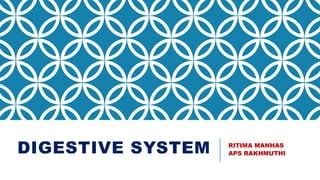
digestive system class 10
- 1. DIGESTIVE SYSTEM RITIMA MANHAS APS RAKHMUTHI
- 2. NUTRITION : All the processes such as respiration, nutrition, circulation, excretion etc. that are necessary for the survival of the living organisms are known as life processes. Modes of Nutrition The two most common types of nutrition are: autotrophic nutrition heterotrophic nutrition.
- 3. AUTOTROPHIC NUTRITION It is a type of nutrition in which inorganic materials such as carbon dioxide, is used up to synthesise organic food by a process known as photosynthesis. For example, green plants use an autotrophic mode of nutrition. Organisms that use the autotrophic mode of nutrition are known as autotrophs.
- 4. HOW DOES AUTOTROPHIC NUTRITION OCCUR IN PLANTS USING PHOTOSYNTHESIS? For photosynthesis to occur, carbon dioxide, water, sunlight and chlorophyll are the required as raw materials. Sunlight provides energy, chlorophyll is used to absorb the sunlight, carbon dioxide is reduced to carbohydrates and water is oxidised to release the oxygen. Water is taken up from the soil through the roots. The site where photosynthesis occurs is known as chloroplast. They contain a green colour pigment known as chlorophyll that traps sunlight for photosynthesis. The steps of photosynthesis are as follows- •Absorption of light by chlorophyll. •Conversion of light energy into chemical energy. •Splitting of water into hydrogen and oxygen. •Finally, reduction of carbon dioxide into carbohydrates.
- 5. STOMATA Leaves contain small openings known as stomata which helps in the exchange of gases. The stomata/stoma is surrounded by a guard cell which guards the opening and closing of stomata. Guard cells also contain chloroplast.
- 6. THE OVERALL EQUATION OF PHOTOSYNTHESIS IS:
- 7. HETEROTROPHIC NUTRITION In this mode of nutrition, an organism is unable to synthesise its food. It is of the following types- 1.Holozoic nutrition is a type of nutrition where an organism takes in whole food and breaks it inside the body. For example, Amoeba. 2.Saprophytic nutrition is nutrition in which organisms feed on dead and decaying matter. For example, fungi. 3.Parasitic nutrition is nutrition in which an organism feeds on a living host. For example, Cuscuta.
- 8. NUTRITION IN HUMAN BEINGS Humans consist of the alimentary canal which starts from the mouth and ends at the anus. The parts of the alimentary canal are as follows- 1.Mouth 2.Pharynx 3.Oesophagus/food pipe 4.Stomach 5.Small intestine 6.Large intestine 7.Rectum 8.Anus
- 10. MOUTH Mouth is the first portion of the alimentary canal. The mouth consists of a muscular tongue and teeth. The cavity inside the mouth is known as the oral cavity. Types of teeth present in mouth: a. Incisors b. Molars c. Premolars d. canine
- 11. MECHANISM OF DIGESTION OF FOOD •Food digestion process begins in the mouth. Food is complex in nature. •To break down food and absorb it, we need biological catalysts known as enzymes. •The mouth contains salivary glands that secrete saliva. Saliva contains an important enzyme known as the salivary enzyme that breaks down starch into simple sugars. •The food then passes via the oesophagus into the stomach. The movement of the food inside the oesophagus occurs via rhythmic contraction of muscles, this is known as peristalsis. • The stomach contains gastric glands that secrete mucus, hydrochloric acid and pepsin. Pepsin is a protein-digesting enzyme. •After the stomach, food then enters the small intestine. The small intestine is larger in herbivores due to cellulose digestion compared to carnivores.
- 12. . •Complete digestion of carbohydrates, proteins and fats occurs in the small intestine. •The small intestine receives secretions from the pancreas and bile from the liver. Bile helps in the emulsification of fats whereas the pancreas secretes enzymes such as trypsin for protein digestion. The intestinal wall also contains glands that secrete intestinal juice. •The small intestine has villi that increase the surface area for the absorption of food. •The unabsorbed food is then transferred to the large intestine where water is absorbed. •Undigested food is then expelled out from the anus.
- 13. CASE STUDY -1: Carbon and energy requirements of the autotrophic organism are fulfilled by photosynthesis. It is the process by which autotrophs take in substances from the outside and convert them into stored forms of energy. This material is taken in the form of carbon dioxide and water which is converted into carbohydrates in the presence of sunlight and chlorophyll. Carbohydrates are utilised for providing energy to the plant. a. Write a chemical reaction which occur during photosynthesis? b. What is stomata? Write its functions. c. What is chloroplast ? d. Draw structure of stomata.
- 14. CASE STUDY -2: Heterotrophic nutrition is a mode of nutrition in which organisms obtain readymade organic food from outside sources. The organisms that depend upon outside sources for obtaining organic nutrients are called heterotrophs. Heterotrophic nutrition is of three types: saprophytic, parasitic and holozoic nutrition. (i) In which of the following groups of organisms food material is broken outside the body and absorbed? (a) Mushroom, green plants, Amoeba (b) Yeast, mushroom, bread mould (c) Paramecium, Amoeba, Cuscuta (d) Cuscuta, lice, tapeworm
- 15. . ii) Which of the following is a parasite? (a) Yeast (b) Taenia (c) Amoeba (d) Earthworm (iii) Which of the following is an example of saprotroph? (a) Grass (b) Mushroom (c) Amoeba (d) Paramecium iv) Heterotrophic nutrition involves (a) production of simple sugar from inorganic compounds (b) utilisation of chemical energy to prepare food (c) utilisation of energy obtained by plants (d) all of these (v) In Paramecium, food enters the body through (a) mouth (b) pseudopodia (c) cilia (d) cytostomed) all of these.
